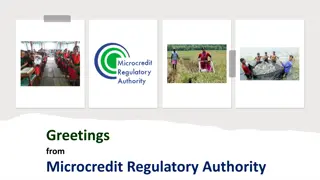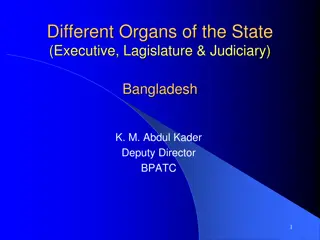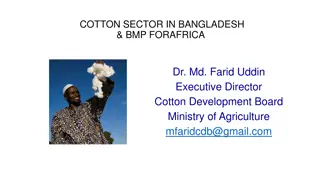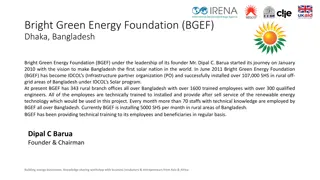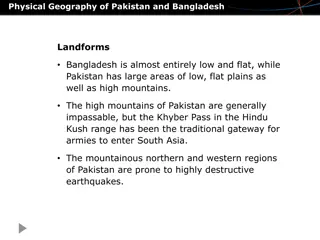Exploring the Rich Ecosystem of Hakaluki Haor in Bangladesh
Hakaluki Haor in Bangladesh is a significant wetland area comprising numerous interconnected beels and jalmahals. Designated as an ecologically critical area, it serves as a vital habitat for diverse fish species and migratory birds. Learn about its geographical features, economic importance, and more in this insightful lesson.
Download Presentation

Please find below an Image/Link to download the presentation.
The content on the website is provided AS IS for your information and personal use only. It may not be sold, licensed, or shared on other websites without obtaining consent from the author.If you encounter any issues during the download, it is possible that the publisher has removed the file from their server.
You are allowed to download the files provided on this website for personal or commercial use, subject to the condition that they are used lawfully. All files are the property of their respective owners.
The content on the website is provided AS IS for your information and personal use only. It may not be sold, licensed, or shared on other websites without obtaining consent from the author.
E N D
Presentation Transcript
Welcome Welcome To Class Class To My My
Md.Kamal Hossain Lecturer Department of English
Lets see two pictures What indicate these pictures?
Todays Lesson HSC English 1st Paper Unit: Twelve Lesson: 02 The Hakaluki Haor
Learning Outcomes At the end of the lesson, you will be able to - Say the location and surrounding areas of the Hakaluki Haor. Say the kinds of fish available in Hakaluki Haor. Say the kinds of migratory birds that visit the Haor in winter. Describe the economic importance of the Haor.
Location and surrounding areas of The Hakaluki Haor The map of The Hakaluki Haor
Hakaluki Haor is one of the major wetlands of Bangladesh. Its area is about 18,386 hectares. This haor is declared an ecologically Critical Area in April 1999 by the Government of Bangladesh.
Hakaluki is a complex ecosystem containing more than 238 interconnecting beels and jalmahals. The most important beels are 1. Chatla, 2. Pinlarkona, 3. Dulla, 4.Sakuna, 5. Barajilla, 6.Balijhuri, 7. Lamba, 8. Tekonia etc.
The The haor haor falls under two administrative falls under two administrative districts districts Maulavibazar Maulavibazar and Sylhet The haor is bounded by the Kushiara river as well as a part of the Sonai-Bardal river to the North. and Sylhet And by the Kulaura-Beanibazar road to the East. And by the Fenchuganj-kulaura railway to the West and to the South
Hakaluki Haor is an important source of fisheries resources for Bangladesh.The main fish species found here are: Boal fish Ghagot fish Rui fish Chapila fish Pabda fish Kalibaus fish
The haor is a very important resting place for migratory waterfowls flying in from the north waterfowls make the haor their temporary home The most important species of The most important species of haor haor is the is the Barheaded Barheaded Goose Goose
Illegal poaching has been a threat to the water fowl population in this vast wetland.
Before Present day The Haor had very dense swamp forest in the past, but deforestation conservation practices have virtually destroyed this unique forest in last two decades. and a lack of
The haor system provides a wide range of economic and non-economic benefits to the local people as well as to the people of Bangladesh. Rice,fruits, oil seed Productions etc.
Buffalo rearing Cattle rearing Duck Rearing
Collection of aquatic and other plants Collection of reeds and grasses
The Hakaluki Haor in dry season It becomes a vast green grassland.
The Hakaluki Haor in monsoon Its scenic beauty makes it a huge natural bowl of water.
Unit: Twelve Lesson: 02 Hakaluki Haor: A rich hub of biodiversity and livelihood
Bangladesh is blessed with huge inland open water resources. It has numerous river canals, beels, lakes, and vast areas of floodplains. Hakaluki haor is one of the major wetlands of Bangladesh. With a land area of 18,386 hectares, it supports a rich biodiversity and provides direct and indirect livelihood benefits to nearly 190,000 people. This haor was declared an Ecologically Critical Area in April 1999 by the government of Bangladesh.
Hakaluki is a complex ecosystem, containing more than 238 interconnecting heels and jalmahals. The most important beels are Chatla, Pinlarkona, Dulla, Sakua, Barajalla, Balijhuri, Lamba, Tekonia, Haorkhal, Tural, Baghalkuri and Chinaura. Hakaluki Haor is bounded by the Kushiara river as well as a part of the Sonai-Bardal river to the north, by the Fenchuganj- Kulaura railway to the west and to the south, and by the Kulaura-Beanibazar road to the east. The haor falls under two administrative districts, Maulvibazar and Sylhet. Some 190,000 people live in the area surrounding the haor.
Hakaluki Haor is an important source of fisheries resources for Bangladesh. Kalibaus, Boal, Rui, Ghagot, Pabda and Chapila are the main fish species found here. From the Kushiara there are frequent upstream movement of fish towards the beels and tributaries of Hakaluki. The beels in Hakaluki haor provide winter shelter for the mother fisheries. In early monsoon these mother fisheries produce millions of fries for the entire downstream fishing communities. Floodplains are also an important source of fisheries resources within the area. However, many of the beels have lost their capacity to provide shelter for mother fisheries because of sand deposits from upstream rivers and canals, use of complete dewatering technique for fishing and lack of aquatic plants to provide feed and shelter for parent fish.
The haor is a very important resting place for migratory waterfowls flying in from the north. The most interesting species is the Barheaded Goose, which is now hardly seen in fresh water wetlands. Many other important species of waterfowls make the Haar their temporary home. Unfortunately, illegal poaching has been a threat to the waterfowl population in this vast wetland. Hakaluki haor is known as a good grazing land in winter. People from villages around the Haar and also from distant areas send their herds for grazing. During this time, herders make temporary shelters near the beels and graze their animals for a period of 4-5 months. The Haar had very dense swamp forests in the past, but deforestation and a lack of conservation practices have virtually destroyed this unique forest in the last two decades.
Two small patches of swamp forests still exist in the area of which one is in Chatla beel and the other near the village of Kalikrishnapur. With the exception of these two swamp forest patches, the vegetation surrounding Hakaluki haor is unique. It includes both swamp forest as well as mixed evergreen rain forest. Thatching material is the most useful natural wetland product of the area. The haor system provides a wide range of economic and non-economic benefits to the local people as well as to the people of Bangladesh. These include fish production, rice production, cattle and buffalo rearing, duck rearing, collection of reeds and grasses, and collection of aquatic and other plants. The haor system also protects the lower floodplains from flash floods occurring in the months of April-May, maintains the supply of fish in other lower water bodies and provides habitat for migratory and local waterfowls.
The unique haor system contributes to the beauty of the landscape both during the monsoon and the dry season. In monsoon, its unique scenic beauty makes it a huge natural bowl of water and in the dry season it becomes a vast green grassland with pockets of heels serving as resting places for migratory birds. This unique natural system can be a major attraction for tourists.
Home Work Write a paragraph on The natural beauty of Hakaluki Haor.


